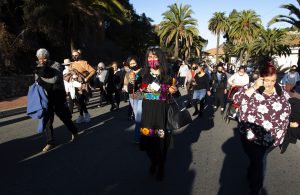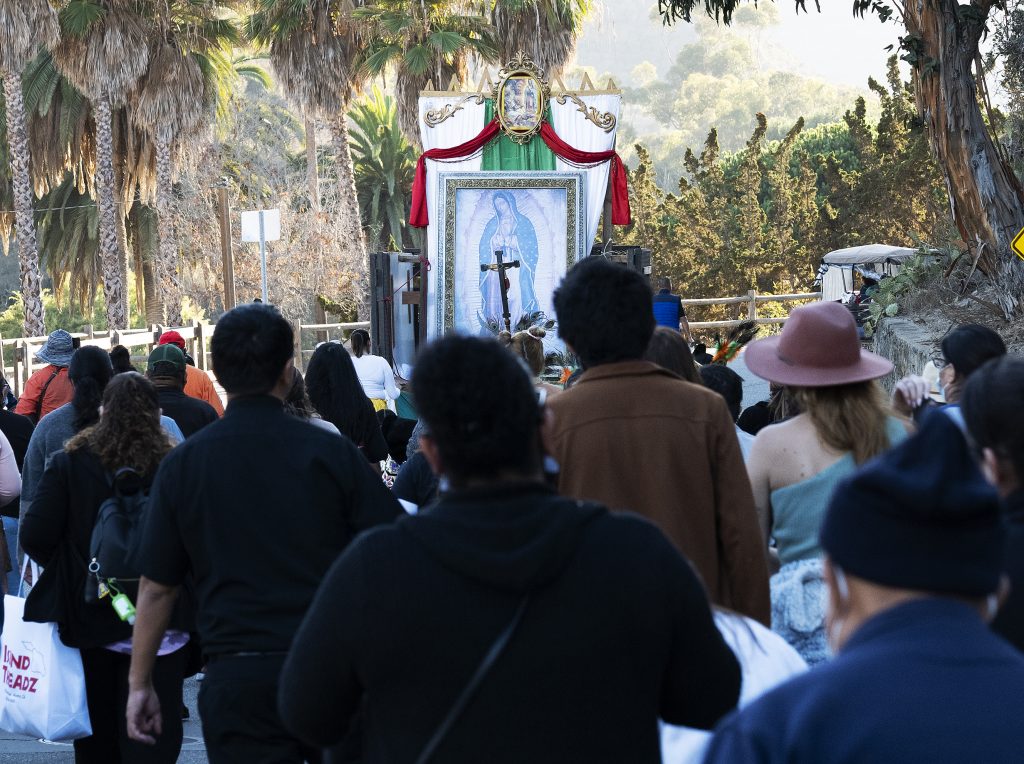Curiosity got the best of the locals.
A joyous procession of prayerful hymns and enthusiastic chanting rang through the tiny residential streets of Avalon on Santa Catalina Island as the sun was about to go behind the central ridge on a late Friday afternoon. It was made up of a mix of some 100 visitors from the mainland and their newfound friends who followed behind framed images of Our Lady of Guadalupe and St. Juan Diego secured to the back of utility trucks.
Neighbors poked their heads out and appeared on their porches. Tourists behind the wheels of electric rental cars stopped in their tracks. Some joined in and asked what the commotion was about.
Among the pilgrims was Auxiliary Bishop Marc V. Trudeau, who sensed a teachable moment for the inquisitive.
“There’s something wonderful about this place — it’s different living here, very laid back,” said Bishop Trudeau, who oversees the San Pedro Pastoral Region that includes Avalon. “So when you can get a parade of people with a couple floats and all the colors, people here can’t help but want to know what’s going on.”

A 2-mile loop starting and ending on the front steps of St. Catherine of Alexandria Church — past City Hall, up Avalon Canyon Road to the historic Bird Park aviary before circling back — gave way to a cavalcade escorted by local Knights of Columbus and cheered on by young children in colorful costumes.
The trek was just one portion of the dawn-to-dark day of pilgrimage on Oct. 22, marking the first of the images’ several stops around the archdiocese leading up to the 90th annual procession of Our Lady of Guadalupe, coinciding this year with the San Gabriel Jubilee Year marking 250 years of Catholicism in Los Angeles.
The day began just after sunrise with Bishop Trudeau’s blessing of the images as they were loaded onto a small boat, Lotus, in Long Beach, serenaded by a mariachi band and young dancers. The boat needed five hours to cross the 26-mile waterway and deliver the pair of 8-by-4 images.
Meanwhile, some 60 pilgrims from nine parishes in the archdiocese made the trip to Avalon in one hour on the Catalina Express.
“It might sound like a slow boat ride,” said Lotus owner Carm Gullo, a parishioner at St. Catherine of Siena Church in Laguna Beach. “But it was very efficient.”
Mark Padilla, a Knight of Columbus for the last 20 years from St. Anthony Church in San Gabriel, has become known as the “chauffeur” of the images as it goes to various events, including to visit the incarcerated in prisons. He said he took the day off his job as a sixth-grade teacher at St. Joseph School in La Puente to orchestrate the delivery, knowing what he experienced at Catalina would be something he could share with his students.
“We see Our Lady of Guadalupe images all through LA in Hispanic communities, but it’s important it comes to Catalina Island and goes everywhere, as it should,” said Padilla. “We need to know her unique message as a guidepost that points us to our faith. I have a great devotion and responsibility to her.”
Maria Aranda, from St. Mary of the Assumption Church in Whittier, followed the procession through Catalina banging her tambourine, joined by her husband and daughter as well as her brother and his wife.
Aranda explained in Spanish how she has attended the parades through LA before, but felt it was important to honor Our Lady of Guadalupe in Avalon after experiencing her presence during a recovery from lymphoma seven years ago.
“She had a lot of pain during the biopsies and chemotherapy and bone marrow transplants, but she kept praying to Our Lady of Guadalupe for giving her the blessing to survive,” translated Aranda’s daughter, Elizabeth Castaneda.

St. Catherine of Alexandria, one of the 22 parishes designated as a “Forward in Mission” pilgrimage site during the jubilee, has history on its side. While established in 1902, its home base of Catalina Island was a recorded site where Masses of thanksgiving were celebrated by Spanish explorer Juan Rodriguez Cabrillo in 1542, as well as Sebastian Vizcaino in 1602 — the latter of which is represented in several murals on the church walls.
As a St. Catherine parishioner, Dina Octavo said she felt blessed the icons could come to her since she rarely is able to leave the island. She has only experienced the processions via the internet.
Octavo said she learned of Our Lady of Guadalupe decades ago when a local prayer group encouraged her to offer prayers as she struggled for eight years to start a family. A month after doing so, Octavo said she became pregnant. She eventually needed an emergency helicopter trip from Catalina to Long Beach to deliver her only son, who is now a 34-year-old paramedic in Avalon.
“Every time I see the image of the Virgin of Guadalupe, I can relive the joy and hope I felt during those moments,” Octavo said. “You can see my emotions. I see how other people experience the faith when they pin the notes on the mantle (green banner draping the icons) asking for help and prayers. Seeing that today has been special to us. Mary brings all of us together.”

As he reflected on the day’s events before the boat trip back home, Bishop Trudeau hoped those taking the trip could realize the pilgrimage was far from finished.
“We’re in such a hurry to get places these days that we don’t always appreciate the process of getting there,” he said. “A pilgrimage is about the process. You don’t stop the pilgrimage when you arrive at the destination. Getting to Catalina wasn’t the pilgrimage. It’s getting back home and continuing that even when you are tired. Looking back on history, it’s wonderful for us to do these small pilgrimages, which are models or snapshots of the larger pilgrimage, which is our lives.”
During an evening Mass before the pilgrims headed back to the mainland, Bishop Trudeau also punctuated a homily with exclamations that were heard throughout the day by the “peregrinos”: “Viva la Virgen de Guadalupe! Viva San Juan Diego! Viva Christo Rey!”
He then added a fourth: “Viva Santa Catalina!”

